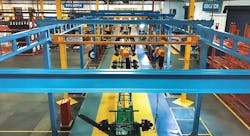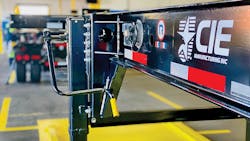Looking to “shield” its customers and workforce from global trade uncertainties, leading US intermodal chassis supplier CIMC Intermodal Equipment LLC is refitting its plants and rebranding. CIE Manufacturing Inc, as the company is now called, is in the process of creating full manufacturing capabilities at its facilities in South Gate CA and Emporia VA. CIE also says it plans to hire an additional 275 people in the US as the facilities ramp up to capacity.
The changes come as the company—which has largely assembled chassis kits manufactured in China by parent company and global trailer giant China International Marine Containers Group Co Ltd—is challenged at home and abroad by a number of factors: a market downturn, tariffs, trade policy uncertainty and, most recently, the China-centered coronavirus outbreak.
“The original motivation to pursue this manufacturing move was the trade war between the US and China, which affected the cost of our chassis,” said Frank Sonzala, CEO of CIE. “When the [initial] tariff was 10%, it really didn’t disrupt our business at all. We all figured out how to work with the 10% and get more efficient and so on. But at [the subsequent tariff rate of] 25%, the customer basically had to buy five chassis to get four—and that made a big difference.
“And it also made a big difference in the buyer’s psyche, the idea that what’s going on here may never end and it’s going to be really hard to do business in the intermodal sector.”
With facilities on the East and West coasts, each with the initial capacity to produce 100 chassis per shift, the CIE Manufacturing goal is to provide domestic customers with lower costs and faster deliveries. Sonzala puts the total investment in the two plants at $10 million.
Combined chassis production for CIMC reached 45,441 in 2018, slipping to 25,369 in 2018, Sonzala reported—and he emphasized that much of the decline stemmed from a market that “totally fell off” to end the year, while tariffs cost the company about two percentage points in market share.
CIMC was to be the beneficiary of a tariff exclusion request for intermodal chassis from China, filed by the American Trucking Associations last August and supported by intermodal fleets and chassis leasing companies. The request contended that fleets were being hurt by the tariff-boosted chassis pricing, and that US suppliers did not have the capacity to meet demand in a timely fashion.
Competing US-based chassis manufacturers successfully opposed the exclusion however, arguing that they had significant chassis capacity that sat idle in 2018 due to a “glut” of trailers from China, imported to get ahead of the tariff charges—and those units, with a short lead time for delivery, made for more attractive replies to bid requests and for an unfair marketplace. The Office of the US Trade Representative denied the ATA request in November.
And while the timing of the production shift is certainly meant to ease immediate concerns, Sonzala noted that he’d first envisioned a US-based manufacturing strategy when he took the reins at CIMC four years ago—for many of the same theoretical possibilities that have since developed into very real problems. He approached the board with a proposal early last fall and was challenged “to get this up and running as fast as possible.”
The South Gate production line, which will be duplicated in the Virginia plant, is designed to be flexible enough to produce the 12 highest-volume products of CIE’s 19 offerings.
The five-station line features overhead cranes that transport the chassis frame through the various stages of assembly in 15-minute intervals. The process begins with attaching the axles, springs, and landing gear to the frame, followed by the installation of “operational systems” (such as air and brake lines, brake adjustments, etc.); the “identification area” is where customer decals, mud flaps, and VIN plates are affixed; in a preliminary inspection station, the systems are tested; and then, at the final quality control station, every chassis goes through a 125-point inspection.
The significant difference between the previous operation and the new system, Sonzala emphasized, is that everything except for the chassis frame is sourced by CIE from US suppliers. Production currently still relies on frames bought from CIMC in China, but Sonzala said he is working with a supplier to establish a powder-coating facility so that a high-quality KTL finish can be applied domestically—and additional manufacturing work can be performed in the US.
In addition to the KTL powder coat, all CIE intermodal chassis come standard with radial tires, LED lighting, and anti-lock brakes. The Revere chassis also carries a 10-year warranty on non-wear parts, he added.
“Now, we see so many benefits to the decision, including creating jobs in US communities and building capacity to produce upwards of 60,000 chassis a year for the US market,” Sonzala said. “I truly believe that this positive move into North American manufacturing will be best for our customers, our employees and the entire intermodal industry.”
About the Author
Kevin Jones
Editor
Kevin has served as editor-in-chief of Trailer/Body Builders magazine since 2017—just the third editor in the magazine’s 60 years. He is also editorial director for Endeavor Business Media’s Commercial Vehicle group, which includes FleetOwner, Bulk Transporter, Refrigerated Transporter, American Trucker, and Fleet Maintenance magazines and websites.
Working from Beaufort, S.C., Kevin has covered trucking and manufacturing for nearly 20 years. His writing and commentary about the trucking industry and, previously, business and government, has been recognized with numerous state, regional, and national journalism awards.


